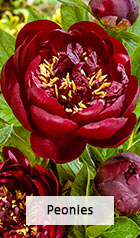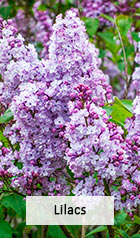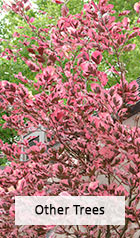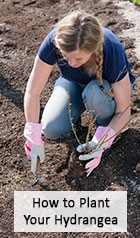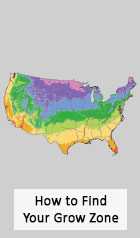- Fall Preview
- Perennials
Close X
Reliable color year after year.
- Bulbs
Close X
Fill your summer with blooms.
- Clematis & Vines
Close X
Provide ambiance and romance.
- Shrubs
Close X
Habitat, color & design possibilities.
- Trees
Close X
A gift for the next generation.
- Patio Orchard
- Fruits
- Tools & Décor
Close X
The right tools make gardening a pleasure.
- Spring Clearance
- Gardening Resources
Close X
Tips and tricks for easy, beautiful gardens.
-

-
Evergreen Hedges
Ever notice how some landscapes look impressive, even in the dead of winter? Chances are they include evergreen shrubs and bushes. That splash of green adds color to the landscape year-round. Evergreen shrubs are easy to fit into your garden or landscape, no matter your space requirements or gardening style. Some evergreens, like boxwoods, are well suited for formal gardens. Arborvitae are favorites for planting as hedges. Conifers work in a variety of settings. No matter what type of evergreen shrub or bush you choose, you can count on Ready, Set, Hedge!™ shrubs to establish quickly and to give your garden a more mature-looking environment on planting day. That's because these evergreen shrubs are grown in the sandy, nutrient-rich fields of Holland, Michigan, where they establish robust, large roots that help the plant grow quickly.
How to care for evergreen shrubs?
Smart siting is the key to success with evergreen shrubs. It's a well-known adage that evergreen trees belong on the north side of houses and buildings, to protect them from strong sun and winds. However, one of the great things about evergreen shrubs is their ability to act as privacy barriers, no matter where on your property they're planted. If you live in an area with high winds or scalding sun, choose varieties of evergreens or arborvitae that are wind-resistant, or consider using fencing to protect your evergreens. Evergreens prefer a mix of sun and shade, and generally require well-draining soil. However, evergreens are a wide and varied group, and some varieties are able to tolerate water or shade.
For established hedges and shrubs, care comprises two parts--pruning and nutrition. While modern evergreen varieties require little pruning to grow in an attractive, natural shape, most require a bit of pruning to maintain their overall form and to prevent crossed branches or disease. Mature arborvitae and boxwoods don't typically require fertilization, but actively growing evergreens may require nitrogen through compost or commercially available fertilizer.
In addition to pruning and fertilizations, many evergreens require care at the most basic level--they don't like to be dried out during the growing season. During any spring or summer dry spells, be sure to water your evergreen shrubs at least weekly. An application of mulch around the base of your conifers can also help to keep them from drying out.
When to plant evergreen bushes?
The best time to plant evergreen bushes is in the spring, giving them plenty of time to establish roots through the summer before chilly weather sets in. Ideally, you should set your arborvitae and other conifers very early in spring, to allow springtime rains to water them in well. Early spring planting also helps your young plants avoid summertime burn.The planting season can continue into late spring--just make sure your shrubs get plenty of water. Note that it is normal for newly transplanted evergreens to exhibit slow growth until they're established, so you may not see much growth within the first year.
What kind of fertilizer for evergreen shrubs?
What kind of fertilizer is best for evergreen shrubs? Nutrition depends upon both your evergreen varieties and your soil type. In general, evergreens like slightly acidic soil, as they do not absorb as many nutrients in alkaline settings. Most amendments and fertilizers for evergreens will focus on adding acidity and nutrients, such as nitrogen.
How can you tell if your evergreens need fertilization? You may see signs of stress, like short needles or a lack of growth in a plant that should be established. Plants that have experienced damage from weather or insects may also require fertilization. And, if you live in an area with poor soil nutrition or alkaline clay, fertilizer can help meet your evergreens' needs. If you're unsure of your soil type, consider soil testing before adding amendments.
Many gardeners swear by using coffee grounds or other organic material to dress the area around their evergreens, and compost certainly can help these gorgeous hedges stay green year round. Don't skip on commercially-available fertilizers, however. Most evergreens benefit from a fertilizer higher in nitrogen, or a balanced fertilizer like 10-10-10. Add lime or another acidifier to correct alkalinity if your soil pH falls below 7. Granular fertilizer is often the best bet, as fertilizer spikes don't provide a wide enough "spread" for the wide roots of an evergreen shrub.
How to prune evergreen bushes?
Most evergreens are cultivated to grow in a particular shape--pyramidal, columnar, round or square--and modern evergreens and arborvitae tend to hold their shape beautifully with little pruning. However, even if you prefer a less-tidy look, most evergreens require a little pruning to stay healthy.
In general, evergreens including pines, spruces, and firs, grow fresh buds on the tips of their twigs. However, some species like arborvitae, cedar, and juniper grow new wood at random locations across the branch. While you're pruning, cut along the natural branching pattern to maintain the shape of your evergreen, and cut a single branch at a time. Be sure to remove dead, diseased, or broken branches. Don't remove more than one-third of the plant's growth in any given year.
If you have an evergreen that looks "dead inside"--the needles are missing or the branches are browning everywhere but the tips of the plant--you may need to use thinning cuts. To thin, you need to remove full branches down to the base, allowing light and air to reach the center of the plant. Remove the oldest wood first.
When to trim evergreen shrubs?
The best timing typically falls in early spring or mid-summer, both periods when evergreens are in a semi-dormant state. Pruning while the plant is resting allows the plant to heal itself before the next round of growth.



